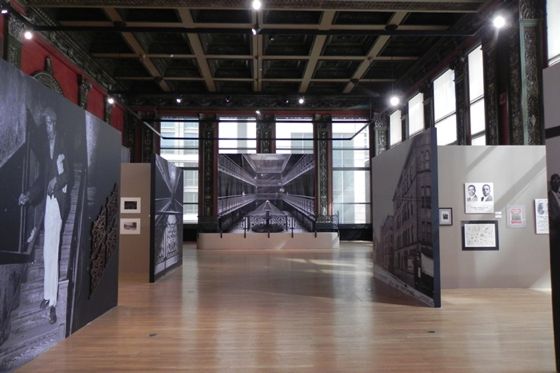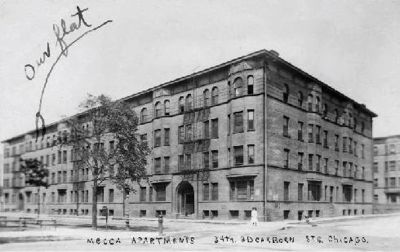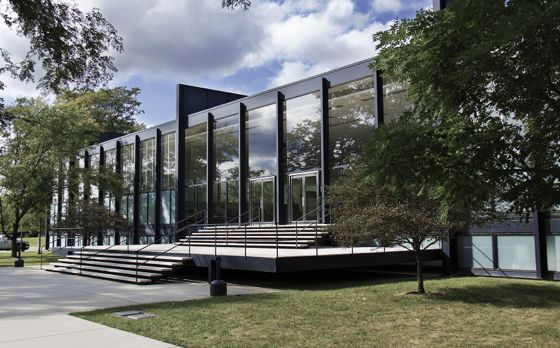| « Draft Day, Oculus, Rio 2, Cuban Fury, Joe, Dom Hemingway & Cheap Thrills | Dorian at House Theatre: It's All About the Movement » |
Architecture Mon Apr 14 2014
"Mecca Flat Blues": Where Modernism Began in Chicago
 34th and State: It's the corner where one grand Chicago era ended and a new one began. It's the place where modernism took root in Chicago.
34th and State: It's the corner where one grand Chicago era ended and a new one began. It's the place where modernism took root in Chicago.
The block on 34th Street between State and Dearborn streets was the site of the Mecca Flats, a square-block-size apartment building constructed in 1892 and demolished 60 years later. The exhibition Mecca Flat Blues at the Chicago Cultural Center tells the story of the Mecca in large-scale historic photographs that show the building's interiors and tell stories of the building's residents.
The Mecca Flats exhibit was curated by Tim Samuelson, Chicago's cultural historian. He presented a gallery talk in March about the Mecca and Thomas Dyja gave a lecture last week on the battle to save the Mecca in the 1940s and '50s. (Dyja is author of the cultural history The Third Coast: When Chicago Built the American Dream, now out in paperback. The book won the 2013 Heartland Prize for nonfiction.) Both events had large turnouts.
 The Mecca was designed by architects Willoughby J. Edbrooke and Franklin Pierce Burnham (no relation to Daniel). Their other notable buildings are the Kane County (Illinois) courthouse, the Georgia State Capitol and the Golden Dome at Notre Dame University.
The Mecca was designed by architects Willoughby J. Edbrooke and Franklin Pierce Burnham (no relation to Daniel). Their other notable buildings are the Kane County (Illinois) courthouse, the Georgia State Capitol and the Golden Dome at Notre Dame University.
 The Mecca was a 96-unit building, constructed of Roman brick, stone and terra cotta. It was made up of two large wings with a large landscaped courtyard where carriages and later automobiles could deliver residents. The building was designed for middle class tenants with large apartments furnished with gas ranges and refrigerators and large windows. Each wing featured a skylight interior courtyard--34 feet wide and 178 feet deep--ringed by apartments.
The Mecca was a 96-unit building, constructed of Roman brick, stone and terra cotta. It was made up of two large wings with a large landscaped courtyard where carriages and later automobiles could deliver residents. The building was designed for middle class tenants with large apartments furnished with gas ranges and refrigerators and large windows. Each wing featured a skylight interior courtyard--34 feet wide and 178 feet deep--ringed by apartments.
The Mecca was used briefly as a hotel during the World's Columbian Exposition in 1893. Retail shops lined the 34th Street façade at street level. Madame C. J. Walker operated a shop where she sold beauty and hair products.
State Street was part of Chicago's entertainment district where jazz and blues developed in the 'teens and '20s. Chicago was the center for recorded "race music." The 1924 song "Mecca Flat Blues" was written by boogie-woogie/ragtime pianist Jimmy Blythe and Alexander Robinson and released on Paramount Records. (Other Paramount artists included Ma Rainey and Blind Lemon Jefferson.) You'll hear the song playing on the sound system as you enter the Yates gallery. Here's an old recording with Blythe accompanying singer Priscilla Stewart.
Poet Gwendolyn Brooks is also part of the Mecca's history. She worked at one time as a secretary to a "spiritual adviser" who lived at the Mecca; part of her job was delivering goods to other residents, so she went door to door and became acquainted with many of them. She later wrote a poem titled "In the Mecca," which was the title poem in a collection of the same title, published in 1968.
The Mecca's tenants were white and middle class for the first couple of decades. As African-Americans began to move north in the Great Migration, they began to populate the surrounding neighborhood. The building was opened to African-American tenants in 1912. The large apartments were divided into smaller units.
From the beginning, stories of crimes and scandals were told about the building. Framed news clippings from over the years line the walls of the corridor outside the Yates gallery. As Tim Samuelson said, the Mecca was "a building where stuff happened."
The Depression brought more decline to the Mecca, but the arrival of Ludwig Mies van der Rohe in Chicago in 1937 would spell the beginning of the end for the building.
Mies accepted an offer to head the department of architecture of what would become the Illinois Institute of Technology. IIT was formed in 1940 by the merger of Armour Institute of Technology (founded in 1890) and Lewis Institute (founded in 1895). Mies was asked to design the new campus, which would be located in the same neighborhood as the Mecca. From 1941 on, the Mecca was destined for demolition, although its residents managed to delay it for 10 years. At the end of 1951, all tenants moved out of the building and demolition began in January 1952.

The building that rose on the site of the Mecca is S.R. Crown Hall, considered Mies' masterpiece and a landmark to mid-century modernism. Built to house the IIT school of architecture, it has been designated a Chicago Landmark and a National Historic Landmark.
Thomas Dyja says, "I can't look at Crown Hall without thinking of the Mecca."
The exhibit Mecca Flat Blues is on display at the Chicago Cultural Center, 78 E. Washington St., through May 25, in the Sidney R. Yates Gallery, 4th floor, Randolph Street side. Admission is free. The building is open every day; hours vary. For more information, call 312-744-3316 or visit the cultural center website.
Photos courtesy Chicago Cultural Center and Wikimedia Commons.









Kevin Killion / October 18, 2014 2:46 PM
"Crown Hall, considered Mies' masterpiece and a landmark" ... While attending IIT, I learned to detest the Mies buildings. I still have nightmares about giant black rectangles.